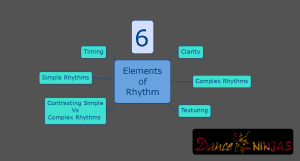Be careful!
“Rhythm” is a loaded term.
ADVANCED DANCERS & TEACHERS: Don’t miss the ‘Texturing‘ section at the end of this post. It will show you one of the most underused, awesome aspects of rhythm.
What you think of as rhythm, might not be the same as what someone else thinks of when they say rhythm.
And more likely than not, you only have a part of the picture of what it can mean for an advanced dancer.
Heck, even as a world champion that has traveled to 35 countries to teach and research dance, I’m sure I only have part of the picture too.
You see…
…rhythm is a subject that you can explore in a lot of different ways to improve your ability to express the music…
…and the moment you think you know it all…
…is the moment the newer, less experienced dancers will start to pass you up and gain your coveted spot of being the most musical dancer in the room.
Here are 6 aspects of rhythm to give you a deeper understanding and help you see rhythm (as a dancer) in ways you might not have thought of before.
MUSICIANS: I apologize ahead of time.
Some of the words I use will not be the terms used from the stand point of a musician. Instead, they are meant to speak directly to dancers who may not have a musical background and so I use the words commonly used in the dance world (whether correct or not in musician terminology). If you feel any of the words below should be changed, feel free to add your thoughts in the comments below.
Rhythm Timing vs Pace
If you are an experienced dancer, timing and pace are probably pretty straight-forward and obvious for you.
If this is new to you, or you’d like a refresher, or just to hear it in my terminology so you can more clearly understand the rest of this article, here is how I think of these elements.
Timing is what many people think of when they think of rhythm.
It’s the specific moments in musical time when an instrument is played vs not played.
Whereas, the pace is simply how fast the timing is being performed.
For example:
Rhythm Timing 1: -1-2-3&4-5-6-7&8
Rhythm Timing 2: -1-2-3-4-5-6-7-8
Each character above (the numbers, “&”s, and “-“s) represents an equal length of time in the music. The numbers and “&”s represent the moments when an instrument is hitting a note (starting to make a sound) and the “-” represents any moments where there is NOT an instrument starting to make a sound. (Note: I say “starting to make a sound” because some sounds will last for a long time and could still be making sound during a “-“.)
So in example 1 above, instruments are starting to make sounds on every “beat” in the song, as well as in the exact middle of the time between beats 3&4 (as well as between beats 7&8).
Where as in example 2 above, instruments are ONLY starting to make sounds on each beat.
These are different timings.
The pace is how quickly (or slowly) a rhythm’s timing is performed.
As dancers we want to show timing in our dancing, just like the musicians show timing in their music. Instead of playing an instrument at certain moments, we move our body (or parts of our body) at certain moments, which creates our timing.
Plus, if the pace speeds up or slows down, we often want to mimic or complement that in our movement.
Check out this video where I discuss the difference between timing vs pace when it comes to rhythm for dancers.
Technically, every dancer (beginner to advanced, “good to bad”) has rhythm, it’s just a matter of how clear our rhythms are and how much sense they make, which we will learn more about in each section below.
Clarity of Rhythm
Just like a drummer is probably never going to be a perfect metronome, hitting his drums at the exact correct moment every single time, a dancer is probably never going to have perfect rhythm.
We can always improve (and it’s very important for competitions, as we will discuss below) and make our rhythms more and more clear and precise.
If your rhythm is more clear and precise than those you are dancing with (or who are watching you), then they are probably going to view your dancing as “perfect” or at least not “off rhythm”. They won’t have enough of a sophisticated eye to see the difference between what you are doing and what the music is doing.
This is why some dancers don’t do well in competitions even though the crowd might have thought they were awesome. The crowd might not have the sophisticated eye to see how far off the rhythm the dancers are, whereas the judges often do.
Check out this video where I discuss clarity of rhythm of a dancer compared to a metronome and how this affects your partner.
Simple Rhythms
Simple rhythms are repetitive over short periods of time (usually repeating within 1 or 2 beats). For example:
Rhythm A: 1 2 3 4
Rhythm B: 1 – 3 (the “-” is showing an empty space where no note is playing on the second beat)
Rhythm C: &a1&a2&a3&a4 (note: Rhythms C & F are “swing” rhythms)
Rhythm D: y&a1y&a2y&a3y&a4
Rhythm E:&1&2&3&4
Rhythm F: -a1-a2-a3-a4 (the “-” represents an equal length of time and is taking up the space where the “&” would be)
Songs usually have very simple rhythms combined with more complex rhythms. As a dancer, it’s important to be able to hear and interpret simple rhythms (as well as complex rhythms).
Many times, you will even want to filter out some of the complex rhythms, to show your partner/audience the underlying simple rhythms.
Check out this video where I share some simple rhythms with my voice.
Beginners Simple Rhythm Exercise
Step 1. Pick any one simple rhythm. For example:
Rhythm 1: 1,2,3,4
Rhythm 2: 1 – 3
Rhythm 3: &a1&a2&a3&a4
Step 2. Pick any one simple move. For example:
For Lindy Hop: Applejacks
For Tango: Walking
For Blues: Fishtails
Step 3. Perform your ONE move, 3-5 times while only emphasizing your ONE rhythm.
Step 4. Perform the SAME move, 3-5 times with a different simple rhythm.
Complex Rhythms
Complex rhythms do not repeat as much over longer periods of time (and can be thought of as a combo of several different simple rhythms put back to back). For example:
Rhythm A: 1-2-3&4-5&-&7&8 (again, the “-” represents an equal length of time and is taking up the space where the “&”s & the “6” would be)
Rhythm B: 1—3-4&5–&7-8
Rhythm C: –1–2-a3-a4–5–6&a7&a8 (this is a “swung” rhythm, and the “-” in this case represents an equal length of time where either the “&” or the “a” would normally be)
To avoid monotony in your dancing, try adding in (or copying from the music) a few complex rhythms within your movements…
BUT DON’T OVERDO IT on the social dance floor! (see Contrasting Simple & Complex Rhythms below for why)
Check out this video below where I break down some simple and complex rhythms with my voice and the music and also discuss the difference between swing (or swung) songs vs straight songs.
By the way, when you practice, it’s ok to overdo it so you get some real focused time actually practicing complex rhythms.
To practice, do the same “simple rhythm exercise” as shown above but instead of using simple rhythms for step 1, substitute any of your more complex rhythms.
Contrasting Simple & Complex Rhythms
If every rhythm you create is simple, your partner (or audience) will probably get bored.
If every rhythm you create is complex, it might start to look like you are just doing a lot of nonsensical movements strung together.
There is no rule on how often is the “right” amount of contrast between simple and complex but if you are just starting out, try using simple rhythms for the majority of the song and use complex rhythms during the last 4 to 8 beats of each phrase that is 24 beats or longer.
This is an extreme simplification but it can help you get a feel for it.
Check out this video where I share some examples of contrasting simple and complex rhythms with the music.
Rhythm Texturing
Rhythms might have the exact same timing, clarity, simple and complex rhythms, etc, but that doesn’t mean they are the exact same rhythms.
For example, they can differ in texture.
Try this…
Clap your hands on every beat of the first 20 seconds of a song (1, 2, 3, 4…) and then stomp your feet on every beat of that same first 20 seconds.
Notice that your timing is the same but it still sounds different.
Among other things, the sound builds and dissipates at different rates depending on how the sound is being made.
These differences are what I like to call the texture.
Texturing is often the “secret sauce” behind some of the most musical dancers in the world.
If you can show the difference in the texture of the song’s rhythms by changing the texture of your movements, you will jump light years ahead of the average dancer.
If you can show the difference in the texture of the song’s rhythms by changing the texture of your movements, you will jump light years ahead of the average dancer.
Check out this video where I share some examples of texturing with my voice, my hand, and my hips.
If you like this post… you’ll love our Dance Trainings… check them out below.
Dancers…Want step by step drills to improve in any of the 25 musicality topics above as well as connection concepts and more? Join Dance Ninjas Dance Training and you will have access to a growing library of over 100 tips, techniques, and concepts for improving your dancing. And if what you want to learn isn’t available, just ask for it and we will create it. Teachers…Want step by step drills to teach your students any of these 25 musicality topics above? Join Teachers Learning Teacher Training and you will have access to a growing library of over 100 tips, techniques, and concepts for teaching dance. And if what you want to learn isn’t available, just ask for it and we will create it. |
What elements of rhythm would you add to this list? Reply in the comments below.


